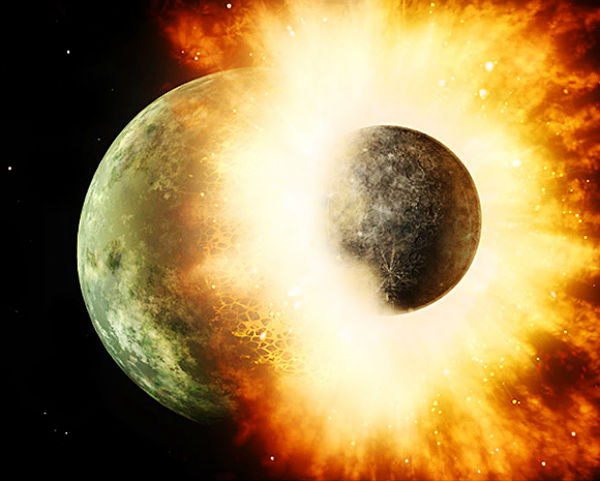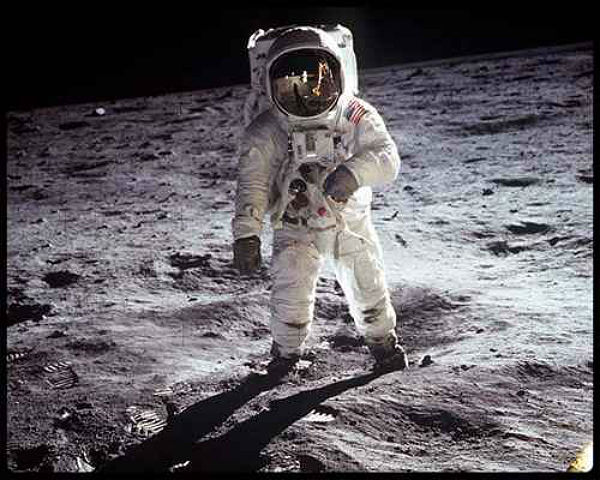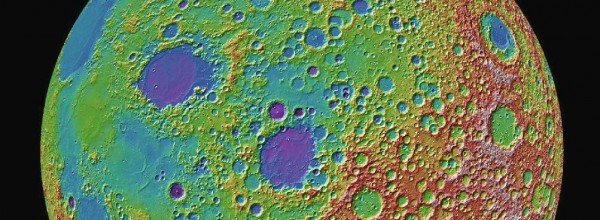Hypothesis: New evidence on origin of the Moon support cataclysmic collision theory

Most researchers agree that the Moon formed five billion years ago from debris blasted off Earth in a giant impact. Scientists presented some new evidence supporting the theory that Moon was, indeed, born of a cataclysmic collision between worlds 4.5 billions of years ago.
In 1975. Journal Icarus, published a paper that suggested the hypothesis of the moon’s origin by two PSI senior scientists – Dr. William K. Hartmann and Dr. Donald R. Davis. Giant Impact Theory suggested that growing smaller planetary body (Mars-sized protoplanet) hit Earth about 4.5 billion years ago, blowing out rocky debris that was captured into orbit around Earth and coalesced into the moon. When the giant impact happened, Earth’s iron core had already formed. The impactor itself also had an iron core which melted on impact and was added to Earth’s core. Some of the debris from the rocky mantles of both Earth and the impactor was ejected into orbit, forming the much smaller Moon. Because so little metallic iron was blown out to orbit, the Moon ended up with a tiny core. And new findings support this hypothesis. The lunar rock samples matched the rocks from Earth’s crust and mantle, but bore no resemblance to the Earth’s interior rock.

Researchers have observed a marked depletion in lunar rocks of lighter isotopes (including zinc) using samples gathered during several Apollo missions and fallen lunar meteorites, comparing that material with Martian meteorites. Frédéric Moynier, PhD, assistant professor of Earth and Planetary Sciences at Washington University, together with PhD student, Randal Paniello, and colleague James Day of the Scripps Institution of Oceanography, measured the ratios of specific isotopes present in the lunar samples.
Scientists presented high-precision zinc isotopic and abundance data pointing that lunar magmatic rocks are enriched in the heavy isotopes of zinc and have lower zinc concentrations than terrestrial or Martian igneous rocks. Paper published in the October 18 issue of Nature, points that the only way for such lunar volatiles to be absent on such a large-scale would be evaporation resulting from a massive impact event.
The Moon is considered to be volatile-depleted and so it has been predicted that volatile loss should have fractionated stable isotopes of moderately volatile elements. One such element, zinc, exhibits strong isotopic fractionation during volatilization in planetary rocks, but is hardly fractionated during terrestrial igneous processes, making it a powerful tracer of the volatile histories of planets. Conversely, Earth and Mars have broadly chondritic zinc isotopic compositions. We show that these variations represent large-scale evaporation of zinc, most probably in the aftermath of the Moon-forming event, rather than small-scale evaporation processes during volcanism. Our results therefore represent evidence for volatile depletion of the Moon through evaporation, and are consistent with a giant impact origin for the Earth and Moon. (Paniello, Day& Moynier – “Zinc isotopic evidence for the origin of the Moon“)
Moynier explains when a rock is melted and then evaporated, the light isotopes enter the vapor phase faster than the heavy isotopes, so you end up with a vapor enriched in the light isotopes and a solid residue enriched in the heavier isotopes. And if you lose the vapor, the residue will be enriched in the heavy isotopes compared to the starting material.
Another research by a team led by scientists from The University of Chicago shows that titanium isotopes are surprisingly similar between the Moon and Earth, further indicating a common origin.

Origin of the Moon theories
One early theory suggested that the moon is a sister world that formed in orbit around Earth as the Earth formed. Lack of iron in the structure of moon could not be explained, so the theory failed. Another early idea was that the moon formed somewhere else in the solar system where there was little iron, and then was captured into orbit around Earth. But this theory also failed when lunar rocks showed the same isotope composition as the Earth.
Another idea was that early Earth spun so fast that it spun off the moon. But this would produce a moon similar to Earth’s mantle, so it failed when analysis of the total angular momentum and energy involved indicated that the present Earth-moon system could not form in this way.
A Russian astrophysicist V. S. Safronov researched the aggregation of planets out of countless asteroid-like bodies called planetesimals in the 1960’s. Dr. William K. Hartmann and Dr. Donald R. Davis suggested the giant impact theory in 1974. They had concluded that in the case of Earth (but not the other planets) the impact happened late enough, and in such a direction relative to Earth’s rotation, that abundant enough middle material was thrown out to make a moon. Harvard researcher A. G. W. Cameron and William Ward were also working on the same idea studying angular momentum in the system. They had concluded the impacting body had to be roughly Mars size (a third or half the size of Earth).
On international meeting about the origin of the moon, in 1984 in Kona, Hawaii, the giant impact hypothesis emerged as the leading hypothesis. Lunar and Planetary Institute (Houston) published the papers from meeting in the 1986 book, Origin of the Moon, edited by PSI scientist William Hartmann, together with Geoffrey Taylor and Roger Phillips. This book is considered the prime reference on this subject.

In Our Created Moon, Don DeYoung and John Whitcomb discuss four main theories suggested for a naturalistic origin of the moon. The fission theory proposes that, while the early Earth was in a molten state, a tidal bulge formed due to the sun’s gravitational pull and eventually separated or “fissioned” from Earth forming the moon. But in that case, it would require the Earth to rotate 10 times faster than the present and the moon should orbit in line with the equator ( it’s orbit is inclined at an 18½ – 28½ degree angle).
The capture theory suggests that the moon was wandering through space and was trapped by earth’s gravity. But according to DeYoung and Whitcomb, there is no known means by which the moon’s velocity could be largely dissipated on a single pass, and the orbit of the moon should be elliptical and not highly circular. However, gas giant planets like Jupiter and Saturn have captured moons. According to Robert Malcuit of Denison University, 4 billion-year-old minerals in Australia suggest that our planet was too cool to have sustained a cataclysmic moon-forming impact early in its history. Malcuit claims that his computer modelling studies show that it is possible for Earth’s gravitational pull to capture the moon. At first, the moon’s orbits would have been highly elliptical, swinging close to Earth and then far away about eight times a year, causing the gravitational pull from each pass to stretch the planet 18 to 20 kilometers (11.2 to 12.4 miles) near the equator, churning the hot mantle and crust. The upper layers of the newly captured moon would have melted from gravitational friction, until the satellite’s orbit stabilized about 3 billion years ago according to Malcuit. Many scientist think that the fact that Earth was cool 4 billion years ago doesn’t mean the moon was captured.

Early nebular or sister theory suggests that both have formed side-by-side from a cloud of gas and dust at the same time. However, gas clouds tend to dissipate unless compressed together by some major outside force which would require both the moon and the Earth to grow at exactly the same rate while maintaining the precise speed of rotation in order to avoid colliding together or drifting apart.
Dr. Hugh Ross suggested that a supreme being made the Moon exactly as it appears in the sky and put it in its present orbit.

The giant impact theory proponents say that Earth had a companion planet around it, placed at a Lagrangian Point (L5 or L4 supposedly). The hypothetical protoplanet Theia was in almost the same orbit of Earth (but 60º out of phase from Earth). Theia as a planet was still growing in size through accretion of matter. Its earlier non-perturbed orbit kept it a safe distance away from Earth. However, as its mass increased through accretion, over a period of 20 to 30 million years, its orbit was destabilized and became increasingly erratic, taking it dangerously close to Earth. 4.53 billion years ago, the increasingly eccentric orbit of Theia lead to its collision with Earth at a very oblique angle. As the two planets collided they stuck together. This led to generation of an immense amount of heat, which led to the melting and sinking of Theia’s Iron core into Earth’s core, sending a significant amount of Theia’s and Earth’s crust, as well as mantle into orbit around them. Almost half of this molten debris coalesced to become our Moon.

The major problem with giant impact theory, according to DeYoung and Whitcomb, is the Earth’s Roche limit – the distance within which a celestial body, held together only by its own gravity, will disintegrate due to a second celestial body’s tidal forces exceeding the first body’s gravitational self-attraction. Inside the Roche limit, orbiting material will tend to disperse and form rings, while outside the limit, material will tend to coalesce. Luckily, our moon is 21 times as far away as the breakup distance.
Dr. Robin M. Canup of the Southwest Research Institute, wrote a Ph.D. dissertation on the moon’s origin and the giant impact hypothesis in the 1990’s, which produced new modeling of the aggregation of the debris into moonlets, and eventually, into the moon itself. Dr. Canup’s research indicates that both bodies in the collision were four to five times the mass of Mars, roughly half the mass of today’s Earth. His theory suggests that after colliding once, the two similar-sized bodies re-collided and then merged briefly before separating into an early Earth surrounded by a disk of material that would coalesce into the Moon. The re-collision and merging left the two bodies with the similar chemical compositions seen today.
In October 15, 2011 Nature published paper by Zhang, Dauphas, Davis, Leya & Fedkin, which suggested that lunar material was derived from the proto-Earth mantle, an origin that could be explained by efficient impact ejection, by an exchange of material between the Earth’s magma ocean and the protolunar disk, or by fission from a rapidly rotating post-impact Earth.
For now, giant impact theory could be considered the most possible one. New findings and research will bring new theories or maybe, new evidence for old theories.
International Observe the Moon Night – October 12, 2013
Sources: The Origin Of The Moon, Universe Today, New Scientist, Nature, Lunar and Planetary Institute, NASA Lunar Science Institute, SouthWest Research Institute, Think & Believe, AOI
Featured image credit: Artist’s impression of an impact of two planet-sized worlds (NASA/JPL-Caltech)

Very interesting.Just speculating,since there is an asteroid belt which may have been an exploded planet, could our moon possible be the mantel or perhaps the core of that planet? In addition with the "fracture zone"and the Great Ocean trenches on the Pacific Ocean floor it looks as if the entire continent of Australia could have been a cosmic body that smacked into the earth. May be that is where all of that water came from that formed the "Ice Cap"?